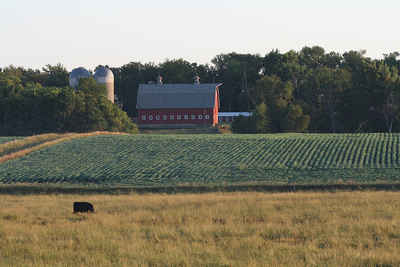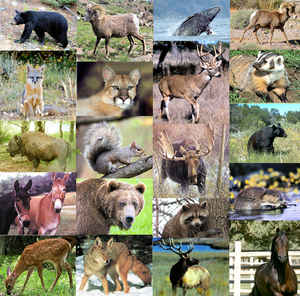South Dakota State Animal
Coyote
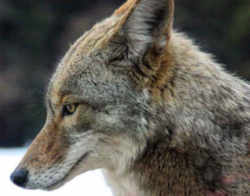
(Canis latrans)
Adopted on March 5, 1949.
It was only right that on March 5, 1949, when Governor George T. Mickelson signed legislation, the coyote, (Canis latrans,) was adopted as South Dakota's state animal. Today, Coyotes range throughout South Dakota. But they are most abundant along the Missouri River and its tributaries and in the Black Hills. The coyote's larger relative, the wolf, once lived in South Dakota as well.
South Dakota State Animal: Coyote
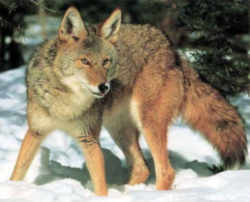
A predator is any creature which gets some portion of its food by killing another animal. However, the concept means very different things to different people. There are many other people who view the coyote in quite a different light. To many hunters, the coyote is a challenging quarry which gives many a thrilling chase. To people who simply enjoy nature, the coyote ranks as one of the most beautiful, intelligent creatures on earth. To many cattle ranchers, he is a symbol of the "Old West" and they enjoy listening tithe yipping song of coyotes at sunrise and sun-set. Fur trappers realize that the coyote can be a valuable furbearer. The eating habits of the coyote don't interfere with the enterprises of these men and so, to them, he is something more than a competing predator.
Characteristics of the Coyotes
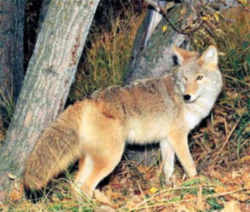
The genus name is the Latin word for dog, Canis. The species name is the Latin word latrans (barking). The common name, coyote, is from the Aztec Indian word coyotl which also means "barking dog."
It is a member of the dog family (canids) which includes wolves, dogs and foxes, and resembles a small German Shepherd. Adults have a grizzled buff grey coat with the outer ears, forelegs, and feet brownish or yellow. The throat and belly are light grey to white; a grey-black band, sometimes very faint, runs down the mid-back. A shoulder saddle of black-tipped hairs is typical. The tip of the tail is black. They have relatively large brains, and exceptional senses of smell, sight and hearing.
Head-and-body length: 70-97 cm. Tail length: 30-38 cm. Shoulder height: 45-53 cm. Weight: 9-16 kg, females 20% smaller than males. An adult coyote is four to five feet long from the tip of its nose to the tip of its tail. Specimens in northeast United States are somewhat larger (Berg, pers. comm.).
Although coyotes avoid wolves and dogs under normal conditions, they occasionally mate with them and create hybrid offspring that are usually larger than a typical coyote. This usually happens where wolf densities are low or on the edge of the coyote's range. Coyotes weighing over 50 pounds are more common in the northern and northeastern portions of their range than elsewhere.
Common names
Coyote; brush wolf, and prairie wolf
Reproduction
Time of mating: Jan-March. Gestation: 63 days. Average number in a litter: 6-18. Duration of lactation: 5-7 weeks. Age at sexual maturity: 1 year, (10 months only in southwest USA., Berg, pers. comm.). Longevity: unknown
Social Behavior
Usually found as breeding pairs or solitary adult females with home ranges of 4 to 143 km2 (Andelt 1985, Springer 1982). In some areas, delayed dispersal of young may lead to pack formation with only the dominant pair (parents) breeding. Young usually disperse at 7-10 months, and may travel up to 160 km, averaging 40-50 km. Pups are born in the den. Coyotes will take over old badger, skunk, or woodchuck burrows or dig their own dens. Social behaviour is reviewed in Bekoff (1977) and Bekoff and Wells (1986).
Diet
Opportunistic predator, will take squirrels, rabbits, birds, poultry, livestock, rodents, insects, carrion, garbage, pronghorn antelope, deer, and mountain sheep.
Distribution and abundance
Widely distributed throughout all of the United States and all of southern and south-central Canada, south through Mexico into northern Central America. Northward expansion of coyotes may be the result of wolf removal, as their range is expanding in areas where wolves have been eliminated for more than a century.
South Dakota Law
The law designating the coyote as the official South Dakota state animal is found in the South Dakota Codified Laws, title 1, chapter 1-6, section 1-6-8.
TITLE 1 STATE AFFAIRS AND GOVERNMENT
CHAPTER 1-6 STATE EMBLEMS
SECTION 1-6-8
1-6-8. State animal. The coyote is hereby designated as the state animal of South Dakota.
Source: SL 1949, ch 242; SDC Supp 1960, § 55.0113.
Taxonomic Hierarchy: Coyote
Kingdom: AnimaliaPhylum: Chordata
Class: Mammalia
Infraclass: Eutheria
Order: Carnivora
Family: Canidae
Genus: Canis
Species: C. latrans





